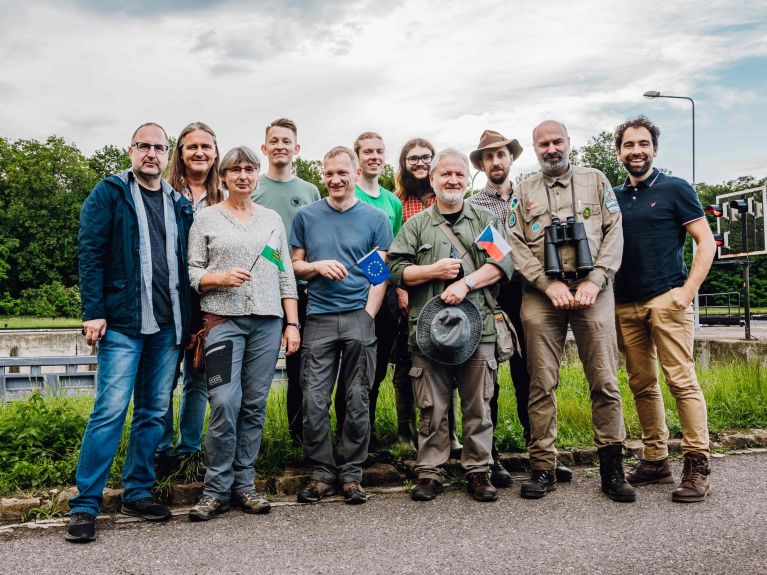Protecting floodplains – across borders
A German-Czech project dedicated to the restoration and preservation of the Elbe floodplains between Dresden and Litoměřice.

Protecting nature and getting other people enthusiastic about doing so too are part and parcel of Victor Geißler’s job description. He works as a biologist for the German Federation for the Environment and Nature Conservation (BUND). And that is precisely the focus of the German-Czech conservation project “Gemeinsam für lebendige Elbauen” (“Thriving Elbe Floodplains Common Initiative”), which Geißler is heading up in conjunction with colleagues from the Dresden Environmental Centre, the Dresden-Neustadt branch of the Nature And Biodiversity Conservation Union (NABU) and the Czech Union for Nature Conservation (ČSOP) based in Litoměřice. The aim is to preserve and restore habitats in the Elbe Valley through cross-border cooperation – and to raise public awareness of the importance of floodplain protection. “The Elbe floodplain landscape isn’t just a beautiful local recreation area. It’s also extremely important for biodiversity and flood protection”, says Geißler.
Floodplains are flat landscapes bordering streams and rivers. Pristine floodplain landscapes are home to communities of plants and animals that “aren’t bothered about getting their feet wet”, says Geißler. “A riparian forest can be flooded for several weeks at a time in a year without the plants’ roots rotting. Other plant communities wouldn’t be able to cope with that. If a normal forest were to be flooded for a protracted period, then the trees might well die.”
Habitat for unique species
This makes riparian forests unique ecosystems. They store nigh on twice as much CO₂ as the average forest does. They provide a habitat for a plethora of unique species – rare birds, bats, amphibians, reptiles, insects. And they make excellent natural flood protection, resisting the force of the water during flooding, absorbing the water like a sponge and storing it for dry spells.
Yet nowadays only one percent of what used to be floodplains still exists. Most of the natural habitats have been lost due to river straightening and intensive use for agriculture, transport and tourism. The same goes for the Elbe between Litoměřice and Dresden. ‘The Elbe used to have plenty of bends. In the Dresden metropolitan area alone there were 18 islands, of which only the Pillnitzer Elbinsel remains today’, explains Geißler. ‘The dearth of floodplains as natural areas for floodwater means that basements are soon inundated during high water.’

Reversing the negative trend in the Elbe
The project “Thriving Elbe Floodplains Common Initiative” is seeking to reverse this trend. The aim is to conserve, enrich and if possible expand habitats in the Elbe Valley. “We’re also planting species of tree that typically thrive in floodplains, controlling invasive varieties of plant and supporting endangered species of animal”, states the Dresden Environmental Centre. The cross-border project is being funded by the EU funding programme Interreg and will span three years.
For the project launch in 2024, the Dresden-based conservationists headed to Litoměřice in the Czech Republic, approximately 60 miles away. “It was impressive to see how many floodplains and islands are still right there in the river”, says Geißler. The German and Czech environmentalists have been liaising with each other on a regular basis ever since. In all areas on which the project partners are working, they start by recording the existing species to ascertain in close consultation which relevant or endangered species there are and which ones could potentially be reintroduced.
“The cross-border aspect is especially important to us”, says Geißler. “We’re organising a German-Czech youth camp this summer, for instance. Each camp will be attended half by German youngsters and half by Czech youngsters, this time in the Czech Republic and next year in Germany.” The programme will include environmental training and the camp attendees will also be collecting rubbish from the floodplains.
Planting campaigns in spring and autumn
Similar activities are regularly organised in Dresden too. These entail collecting, separating and disposing of rubbish and plastic waste that ends up stuck in the floodplain landscape after a flood. There are planting campaigns too, particularly in spring and autumn, which involve planting black poplars to conserve and if possible expand riparian forest populations.
Protecting floodplains is also a political focal point. The federal state of Saxony, for instance, has launched a floodplain programme which will see “suitable selected river sections being gradually reconnected to their natural floodplains” with a view to giving the river more space, thereby bolstering flood protection.


